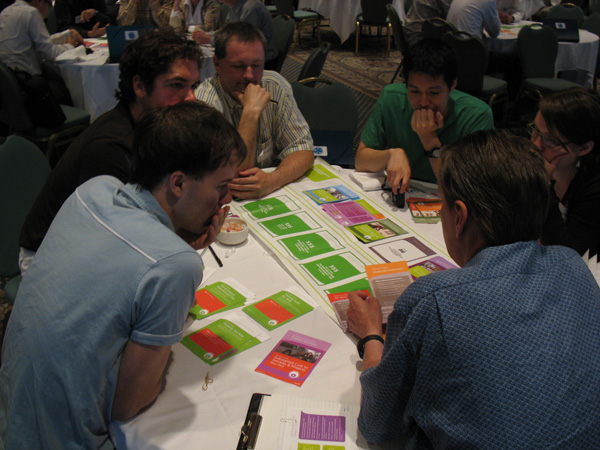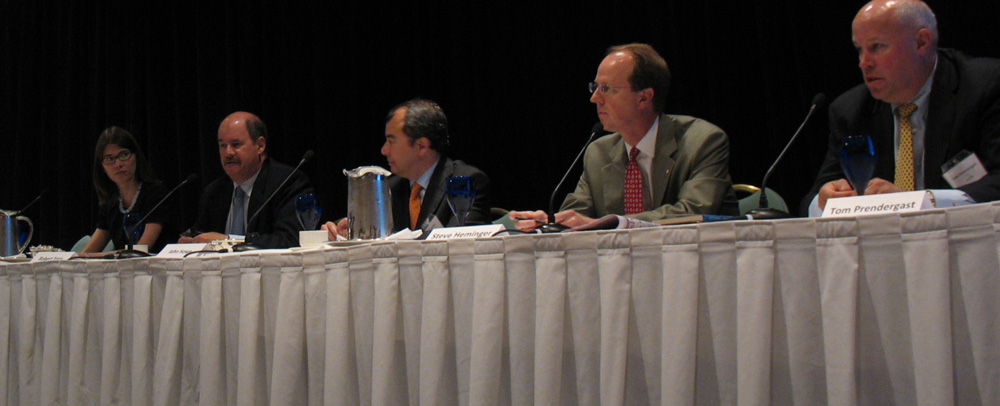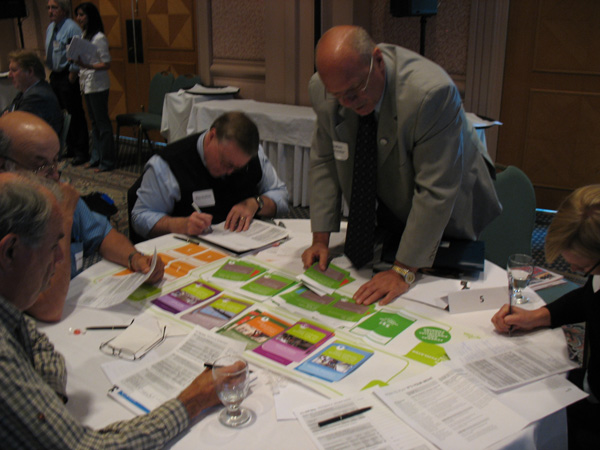Livability Forum kicks off public consultation on our 10-Year Plan
Livability Forum kicks off public consultation on our 10-Year Plan

We held a Livability Forum this morning in downtown Vancouver, launching our consultation on our proposed 10-Year Plan!
The 10-Year Plan outlines the first steps we’ll be taking toward Transport 2040, our region’s 30-year transportation strategy. (We’ll be consulting on it from June 1-30, so please come to our in-person events or visit BePartofthePlan.ca to contribute!)
At the forum, we got a huge group of people in Metro Vancouver together to talk about the related transportation and liveability challenges facing our region. Plus, we heard from experts on similar challenges in other major cities.
And at the end, we got everyone to do a consultation exercise—a board game activity called “It’s Your Move,” that lets you plan and select funding for our region’s transportation priorities.
You can try the board game online, too, at our newly relaunched BePartofthePlan.ca site. (I’ll have more on the new site in a bit.)
Here’s a few more details about what we did today, including details of our draft 10-Year Plan and the financing options available to us, and PowerPoints from all the talks given!
(By the way, this event was originally called the Transportation Forum— I talked about it in May.)
Four experts talk transportation in San Francisco, New York, and more
 [/caption]
[/caption]
Petra Todorovich , director of America 2050, talked about long range planning for sustainable growth, and discussed strategies for the New York region at the national, regional, and local levels. At the end, she emphasized that while things do take time, we should dare to make grand plans! A crisis is a terrible thing to waste. Here’s the Power Point from her presentation (7.1 MB).
Robert Yaro, president of the Regional Plan Association, talked about the challenge of financing New York City’s regional transportation system. This was a great talk that examined the difficulties of securing funding for transportation and how politics and the state legislature come into play. Here’s the Power Point from his presentation (5.8 MB).

John Howe, general manager for investment strategy and projects with Toronto’s Metrolinx, discussed his region’s big plans to cut vehicle use and shift more people over to walking and cycling. John actually mentioned that TransLink was a big influence on the formation of Metrolinx and called us leaders in the transportation field! Here’s John’s Power Point presentation (4.1 MB).
And last, we had Steve Heminger, executive director of the Metropolitan Transportation Commission, the regional transportation planning and finance agency for the nine-county San Francisco Bay Area. Steve gave a great and really funny presentation on tolling: they use extensive tolling in the Bay Area to finance their system, and it seems to work quite well for them. Here’s the Power Point from Steve’s presentation (10.6 MB).
Tom Prendergast presents the draft 10-Year Plan and the liveability challenge facing our region
Our CEO Tom Prendergast also gave a presentation, talking about our proposed 10-Year Plan, the liveability challenges faced by our region, the funding mechanisms we can currently use, and the future revenue sources we are looking to pursue.
You can check out the three choices presented by the draft 10-Year Plan at our newly relaunched BePartofthePlan.ca site: here’s choice 1, choice 2, and choice 3.
But our media relations team actually did a really great video with Tom’s narration over the slides, so you can just sit back and listen to the presentation if you like. Here it is, in three parts:
Part I:
Part II:
Part III:
It’s Your Move: the consultation exercise board game


Last, we got everyone to do that consultation exercise—the board game activity called “It’s Your Move” that lets you make the transportation decisions in our region.
Essentially, you get to pick the transportation priorities for our region, then choose how to pay for it using our existing funding sources.
If you can’t get the numbers to balance, you can also tell us which possible future revenue sources we should go after.
And again you can try the board game out online, too, at our newly relaunched BePartofthePlan.ca site. Honestly, I’d really recommend trying it out—it is a great way to pick your own plans for the region, and see the kind of decisions TransLink has to make when designing these plans.
I’ll have more on the new BePartofthePlan.ca website tomorrow!






Looks like it was a great forum! Are there any future ones planned? I would’ve come but I couldn’t take any time off work!
Yeah, I’m so sorry about the timing of the event. Anyway, there will be more community workshops planned throughout June. The big speakers won’t be there but you’ll probably get to see Tom or one of our top execs talking about TransLink’s challenges, plus you’ll get to play the It’s Your Move game! Here’s a link to the event schedule.
I tried the online It’s Your Move simulation (which is excellent by the way), but I think it’s messing up the sorting on the Summary page for Existing Revenue Sources and Transportation Investments.
Chris: can you be more specific? More detail helps us identify the bugs better :D
Yah I rated 1. Transit 2. Rapid Transit 3. Roads 4. Cycling 5. Customer Service but it ended up orderring 5. 1. 3. 4. 2. or something like that. I just put a note in the additional suggestions anyway.
On Step 3, you’re asked to rank Potential Future Revenue Sources, Existing Revenue Sources, and Transportation Investment. On the Final Result page, the choices you made for Existing Revenue Sources and Transportation Investment are not reflected, but the Potential Future Revenue Sources are. I’m using Firefox, but noticed the same problem when I tried IE.
Some other feedback: I was disappointed to see that even the “Drastic Cuts” option for Customer Service included implementation of a gating system. As Stephen Rees has pointed out several times on his blog, this will end up costing Translink a lot more then it will recoup, with minimal benefit.
Second, has Translink considered a congestion charge like London’s as a means of financing the transit system? In London, their transport system receives around 170 million dollars per year from the congestion charge, which has the added benefit of discouraging people from driving and reducing emissions.
Hi Chris, yes, all options include the gating system, and that’s because the gating system already has committed funding from the Province and the federal government, not TransLink. Here’s the blog post I wrote about the faregates announcement in April.
Also, yes, we are considering fees like a congestion charge. That’s included in the possible future funding source called “Road User Fees” — that source encompasses all types of road tolling including congestion charges. There’s some more explanation about road user fees on this page, which also has a link to a PDF with some more info.
tks for the effort you put in here I appreciate it!
[…] under “Empower.” A group plays It’s Your Move, the consultation exercise board game, during the 2010 10-Year Plan consultation last […]
You know what the huge number of Android phones offered in the market is both a blessing and a curse? Every year, mobile phone developers introduce several new Android phones to keep up with the growing population of smartphone users. On one hand, you’ve the advantage of getting masses of choices. On the other, too many options can be really overwhelming. If youre looking for the best Android phones, then youre in for some task. All the news and media hype make the search especially difficult, since everyone seems to be labeling one phone as the best Android mobile around. If you shop around, youll brainwave that unlike Apples iPhone, Humanoid phones come from different motorized companies, with HTC, Samsung, Motorola, Sony Ericsson, and LG being the most dominant. The major mobile phone service providers dont net the job easier either, because they now also offer an listings of Android units to choose from. ATu0026T, Sprint, T-Mobile, Verizon, and Virgin Wireless are some of the most popular service providers that offer Android phones.
When trying to discovery the best Android phones, first you someone to define the word best. This is truly important because the best handset for one may not be the best handset for you. By this we mean that it isnt about getting the newest or most expensive gadget. Its about finding the best Android mobile phone for you. So, what makes a phone the best for you? Is it the camera, battery life, weight, and processor? These are just few examples of property that you need to consider…Continuation of the article on the blog: http://weltmaster.blogspot.de/2013/09/best-android.html